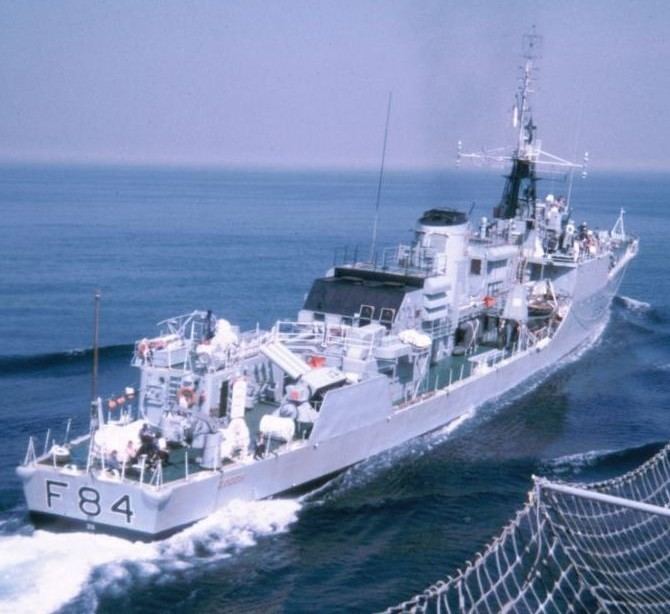In service 1955 (RN) – 1985 (RN) Lost 1 (+1 as target) | Completed 15 | |
 | ||
Builders Swan Hunter, WallsendYarrow Shipbuilders, ScotstounJohn I. Thornycroft & Co., WoolstonAlexander Stephen and Sons, GovanJ. Samuel White, Cowes Operators | ||
The Type 14 Blackwood class were a ship class of minimal "second-rate" anti-submarine warfare frigates. Built for the Royal Navy during the 1950s at a time of increasing threat from the Soviet Union's submarine fleet, they served until the late 1970s. Twelve ships of this class served with the royal Navy and a further three were built for the Indian Navy.
Contents
Design
The Type 14 frigates were designed to be cheaper and smaller than the expensive Type 12 frigates. Although they lacked gun armament, their anti-submarine armament of two Limbo mortars, Mk 20 torpedoes and sonar fit equalled the larger Type 12, and as the crews of the Type 14 concentrated almost entirely on practising anti-submarine warfare, they were often the most effective frigates in anti-submarine exercises until the mid 1960s. The class were entirely specialised for the anti-submarine role and hence had little capability in any other role, though they did perform fishery protection duties during the confrontations with Iceland over fishing rights.
In the late 1950s, during their time on patrols around Iceland to ensure that Iceland did not interfere with British fishermen's attempts to fish, problems were found with the hulls of the Type 14s in such heavy waters, so that their hulls had to be strengthened to cope with these patrols. However, they proved to be good seaboats throughout the dispute, which continued into the mid-1970s. The low profile of the superstructure was a deliberate design feature to confuse enemy attackers. The Type 14 design was flawed by the lack of a gun, and also by a general lack of space. After experience with these frigates, the Admiralty decided to ensure that quality was the top priority of all ships, even though it meant having a smaller fleet.
One of the ships, Exmouth, was later converted 1966-1968 to act as experimental trials vessel for gas turbine propulsion, becoming the first major warship of the Royal Navy to be entirely powered by gas turbines. In this configuration she was easily distinguishable from other members of the class due to her larger (non-cylindrical, streamlined) funnel and large air intakes sited immediately fore and aft of the funnel. The success of these trials led to the adoption of all-gas turbine propulsion as standard on subsequent Royal Navy warship designs (Type 21 & 22 Frigates, Type 42 destroyers, 'Invincible' class carriers).
Service
The Type 14s' limited size, at just 310 feet (94 m), restricted them from continuing past the 1970s and continuing the work as anti-submarine ships. Their small hull limited the extent of modifications and upgrades possible, preventing the Type 14s from being modernised with more effective weapons, effectively rendering them obsolete. All were decommissioned in the 1970s. The last operational were the gas powered Exmouth in 1977 and Hardy which attended the Silver Jubilee of Elizabeth II in 1977 and deployed again from the standby squadron in 1978.
In film
The 1960 Norman Wisdom film The Bulldog Breed was made in Portland harbour with co-operation from the Royal Navy, and features several of the Blackwood-class frigates. An early scene shows a flotilla of Type 14s led by Murray.
Royal Navy
The Royal Navy ships were all named after British captains. Many had been in the Napoleonic wars and some were present at the Battle of Trafalgar.
Indian Navy
Three ships were built for the Indian Navy in the late 1950s
